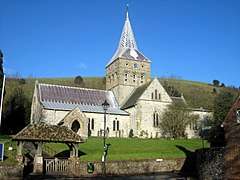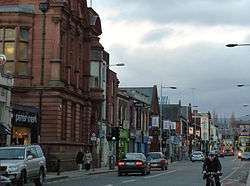William de Meones
William de Meones (died 1325) was an English-born cleric and judge in fourteenth-century Ireland', who was the second Chief Baron of the Irish Exchequer. Today he is chiefly remembered for giving his name to the Dublin suburb of Rathmines.
Career

He derived his name from his birthplace, the village of East Meon in Hampshire.[1] He is first heard of in Ireland about 1279 in the entourage of John de Derlington, who was Archbishop of Dublin 1279-1284, and he was executor of the Archbishop's will.[2] He was also a canon of St. Patrick's Cathedral, Dublin. He was employed to collect Crown revenues in 1285 and was keeper of the Queen's forests at Glencree in 1290.[3]
In 1293 he was Chamberlain of the Exchequer of Ireland and in 1299 was appointed a Baron of the Court of Exchequer (Ireland); this is one of the first references to the Court of Exchequer, which did not then have a full-time staff.[4] He resigned as Baron in 1308 but was reappointed the following year. In 1311 he succeeded Walter de Islip as Chief Baron, but apparently reverted to the status of ordinary Baron in 1313. He died in 1325, and his estates passed to a cousin, Gilbert de Meones.[5]
Placename
It is widely accepted that the de Meones family gave its name to Rathmines, the Rath (ringfort) of de Meones;[6] such a combination of Irish and Norman-French elements in a place-name was not uncommon in medieval Ireland. Elrington Ball, in support of the theory, notes that in the fourteenth century the district was sometimes referred to as Meonesrath.[7]

References
- Ball, F. Elrington The Judges in Ireland 1221-1921 John Murray London 1926 Vol.1 p.58
- Ball, F. Elrington History of Dublin Alexander Thom and Co. 1903 Vol.2 p.100
- Ball 1926 p.58
- Bal 1926 p.58
- Ball 1926 p.58
- Ball 1903 p.100
- Ball 1903 p.100